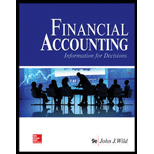
Concept explainers
Provide the names of two (a) asset accounts, (b) liability accounts, and (c) equity accounts.
Concept Introduction:
Assets are physical as well as intangible resources of the business which are kept forproviding future economic benefits.Liabilities are dues or amount payable by the business. Equity represents the sum of capital and profits/ loss earned by the business owners. Net asset is the amount of assets available after payment of liabilities.
To indicate: The names of two assets, two liabilities, and two equity accounts.
Explanation of Solution
Assets: Assets are physical as well as intangible resources of the business which are kept providing future economic benefits. The names of two assets accounts are as follows:
- Equipment: Equipment is an asset purchased for production.
- Land: Land is a long term asset.
Concept Introduction:
Assets are physical as well as intangible resources of the business which are kept for providing future economic benefits. Liabilities are dues or amount payable by the business. Equity represents the sum of capital and profits/ loss earned by the business owners. Net asset is the amount of assets available after payment of liabilities.
To indicate: The names of two assets, two liabilities, and two equity accounts.
Explanation of Solution
Liabilities: Liabilities are dues or amount payable by the business. The names of two liabilities accounts are as follows:
- Accounts payable: Accounts payable is a short term liabilities for payment of purchases.
- Long term loan: Long term loan is a long term liability for payment of loan.
Concept Introduction:
Assets are physical as well as intangible resources of the business which are kept for providing future economic benefits. Liabilities are dues or amount payable by the business. Equity represents the sum of capital and profits/ loss earned by the business owners. Net asset is the amount of assets available after payment of liabilities.
To indicate: The names of two assets, two liabilities, and two equity accounts.
Explanation of Solution
Equity: Equity represents the sum of capital and profits/ loss earned by the business owners.
Net assets: A net asset is the amount of assets available after the payment of liabilities. The names of two equity accounts are as follows:
- Common stock: Common stock represents the amount of investment made by the business owners.
- Retained earnings: Retained earnings represent the accumulated net income of the business.
Want to see more full solutions like this?
Chapter 2 Solutions
Loose Leaf for Financial Accounting: Information for Decisions
- Consider the following accounts, and determine if the account is an asset (A), a liability (L), or equity (E). A. Accounts Payable B. Cash C. Dividends D. Notes Payablearrow_forwardConsider the following accounts and determine if the account is an asset (A), a liability (L), or equity (E). A. Accounts Receivable B. Sales Revenue C. Land D. Unearned Revenuearrow_forwardClassify each of the following accounts as an asset (A), liability (L), or equity (EQ) account. Casharrow_forward
- (See chart below for the account titles) Identify or classify the different account titles as to whether they belong to Assets, Liabilities, Owners' Equity Revenue or Expense of the busi- ness. Fill the amounts of the following SFP and SCI elements: Current Assets: _________ Noncurrent Assets:_______ Current Liabilities: ________ Noncurrent Liabilities: _______ Sales: ________ Expenses: ________ Net Income (Loss): ________arrow_forwardIn which of the following types of accounts are increases recorded by credits? A. revenues and liabilities B. drawing and assets C. expenses and liabilitiesarrow_forwardWhich of the following correctly describes how accounts payable will appear on the financial statements? Multiple Choice O O Liability on the balance sheet Asset on the balance sheet Expense on the income statement Revenue on the income statementarrow_forward
- Describe about the Accounts payable.arrow_forwardexplain the relationship of fi nancial statement elements and accounts, and classify accounts into the fi nancial statement elementsarrow_forwardWhich of the following accounts has a normal credit balance? a. Accounts Receivable b. Yura Wun, Capital X c. Supplies Expense d. Copyrightsarrow_forward
 Auditing: A Risk Based-Approach to Conducting a Q...AccountingISBN:9781305080577Author:Karla M Johnstone, Audrey A. Gramling, Larry E. RittenbergPublisher:South-Western College Pub
Auditing: A Risk Based-Approach to Conducting a Q...AccountingISBN:9781305080577Author:Karla M Johnstone, Audrey A. Gramling, Larry E. RittenbergPublisher:South-Western College Pub College Accounting (Book Only): A Career ApproachAccountingISBN:9781337280570Author:Scott, Cathy J.Publisher:South-Western College Pub
College Accounting (Book Only): A Career ApproachAccountingISBN:9781337280570Author:Scott, Cathy J.Publisher:South-Western College Pub Auditing: A Risk Based-Approach (MindTap Course L...AccountingISBN:9781337619455Author:Karla M Johnstone, Audrey A. Gramling, Larry E. RittenbergPublisher:Cengage Learning
Auditing: A Risk Based-Approach (MindTap Course L...AccountingISBN:9781337619455Author:Karla M Johnstone, Audrey A. Gramling, Larry E. RittenbergPublisher:Cengage Learning- Principles of Accounting Volume 1AccountingISBN:9781947172685Author:OpenStaxPublisher:OpenStax College
 Cornerstones of Financial AccountingAccountingISBN:9781337690881Author:Jay Rich, Jeff JonesPublisher:Cengage Learning
Cornerstones of Financial AccountingAccountingISBN:9781337690881Author:Jay Rich, Jeff JonesPublisher:Cengage Learning College Accounting, Chapters 1-27AccountingISBN:9781337794756Author:HEINTZ, James A.Publisher:Cengage Learning,
College Accounting, Chapters 1-27AccountingISBN:9781337794756Author:HEINTZ, James A.Publisher:Cengage Learning,





